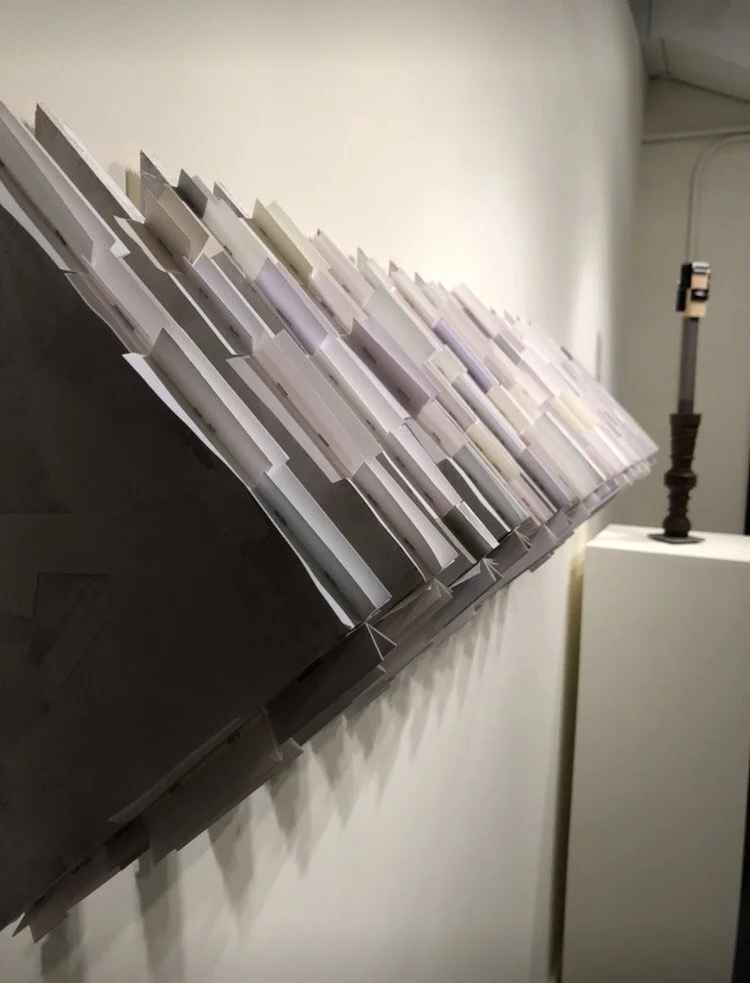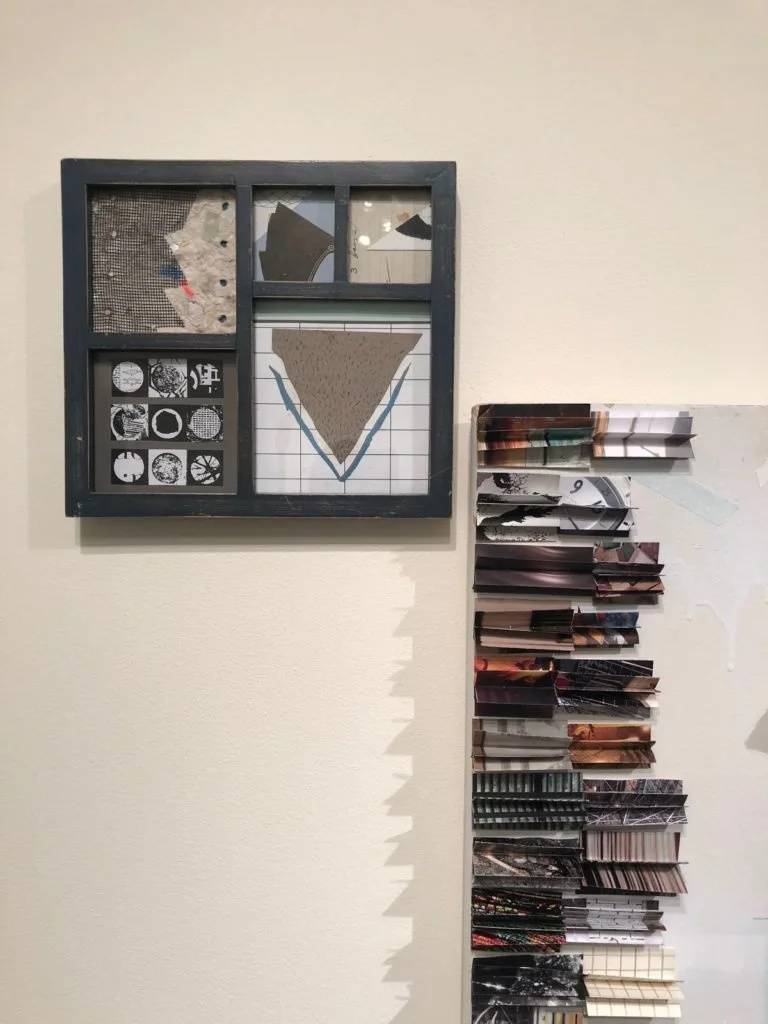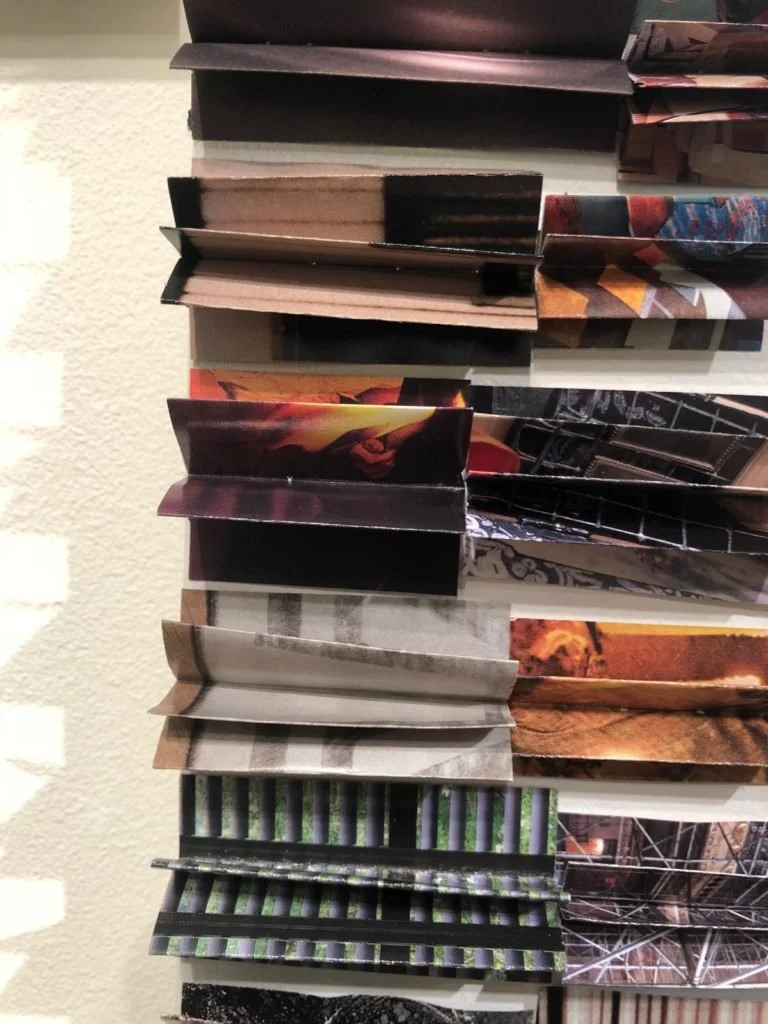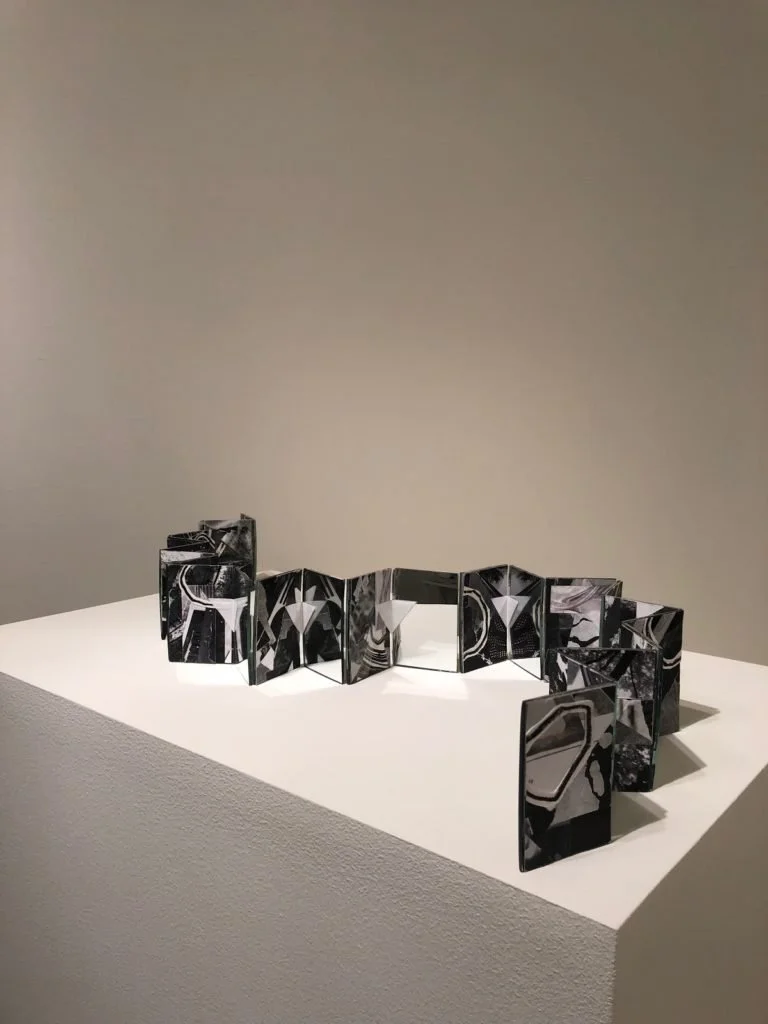Volumes and Violent Joy
Craig Deppen Auge
Volumes
Kiosk Ga llery
January 18th – March 7th
At first glance, Craig Deppen Auge’s work can look chaotic, even frenzied in its making.
Folded paper is combined with collaged canvas on spray painted wood on metal rods, and
on and on. He refers to this obsessive folding, collaging, and assemblage as ritualistic in
nature. Auge grew up in the Appalachian region, where he was informed by a rich history of
folk healing, witchcraft, and tradition that is nestled in the mountains. When examining the
folds, with repeating shapes like triangles and circles, you get a sense that some kind of
fevered spell was cast as he worked until the repetitive action had been exhausted
completely
In considering this rhythm of movement between material, I found parallels between Auge’s
process and music. I often think about art and music in the same headspace. While you can
appreciate a particular composition for academic or conceptual reasons, sometimes you just
like something because you’re attracted to the way it feels; you’re immediately pulled by the
hook or material. This is the way I felt about Auge’s work. A shape, a color, a lyric, a moment
about love lost floating into the ears of the heartbroken. The kind of violent joy a small child
feels as they hold a puppy, all gritted teeth and glistening eyes. A visceral reaction. Often
times the reason one is drawn to an object or song is deeper than initially thought, but the
fact that its mere existence can magnetize you begs further exploration.
Online this experience of being magnetized by images is becoming more and more
universal. We scour websites and instagram accounts for those art pieces that have the
form, color, light, that we know others might be drawn to and pass them around like kids
trading lunch snacks. While Craig Auge’s work could absolutely be treated like one of these
art snacks on small screen, you’d be missing out on deeper narrative if you didn’t personally
delve further into the new works in this exhibition.
These works show pieces of the artist’s memory of home, both real and tangible, in one time
period, now existing as broken down abstractions. This sense of place, longing, and
belonging that these pieces can draw up are universally felt.
In these works, you sense the deep nostalgia and memory of his childhood in West Virginia.
Brightly colored ropes bring about memories of summer camp craft projects. Pieces of
wooden architecture that look like they came from some reluctantly abandoned Victorian
home, a pedestal made from a found coffee table leg, a small decorative embellishment from
an ornate oak door, put together they create an abstract construction of a sacred space. In
the piece Almanac III (Growth Chart, Album) you encounter a wooden panel with blue hatch
marks on one side and successions of folded paper, what he calls “books” that read more
like a textile, on the other side. Looking closely at these books, you discover small,
infrequent human elements among the contrasting patterns – a hand, a clock face, the
exterior of a home. The hatch marks are reminiscent of the lines a proud parent would
scratch on a wall, tracking a child’s growth over the years. To the upper left corner of the
wooden panel, you see a small blue frame that looks like a family photo frame. Each of these
“family photos” are a collage, or piece of a collage, from a different time in his life.
In the piece Stop and Go (Night Blindness) a folded accordion made of small collages are
paired with mirrors of the same size. When you follow along the accordion, you find one
continuous drawing made with wax pencil. Looking at all of the pieces in this show, you find a
sort of feedback loop – the existence of all of Auge’s “times” happening in one space and a
quality of maximalism and minimalism working in tandem. In this piece, you find the minimal,
blank surface of the mirrors reflecting and confronting the maximal layers of unruly collage.
The mirrors reflect your own time, threading it into a small, but complex through-line.
Reflective Chronicle (Muted) is series of canvas-covered wooden triangles, collaged with bits
of paper, tape, paint, pencil, and other materials. The material play and the elements of using
what is readily available to the artist is somewhat childlike in nature, further reinforcing ideas
about nostalgia and home. On the edges of each triangle are multiple pieces of folded paper.
If you were to blur your eyes, this entire installation would look white – blank. But the subtle
differences in shades and shadows create a story. The darkest of these shades – almost
gray – come in the middle of the piece, and just like a book, they have a beginning, a middle,
and an end. Because of the lack of color, Auge increases the interpretive potential of the
works, allowing for the viewer to step into tiny divinatory worlds of tone.
The pieces in this exhibition sprawl, unfold, lean, and play with the ductwork and lines of the
walls above to create an entire composition that can be read from one end of the room to the
other. There is a quality of traditional craft among the abstractions, with the repetition of
triangular shapes, and the interchanging patterns, much like a patchwork quilt. A viewer
could see some of these as unfinished, as though Auge set them up just before you walked
in, or some magically conjured earthquake shook them into place. Either way you sense it is
evidence that something has happened, and that you may not know what will happen next.
What I enjoy most about the work in this exhibition, is that once I read through and
metaphorically listened to all of the work, I felt a calm understanding. While the work may not
always look like the result of a calm hand, the underlying feeling is one of welcoming. It felt
like a reminder from Auge that we all yearn for a place or a time that is no longer, and we all
wonder about who we were, and what we will become. There is an anxiety there that we
experience, but that it is ok, because it is universal. The space that is created by his
movements, and his installation choices, become a shared meditation.
With these threads of time and place in Auge’s work comes an invitation to be present, a
holy binding of future and past. “Volumes” presents itself with a view of both micro and
macro, a composition both loud and soft – a playful story with a deliberate message.








